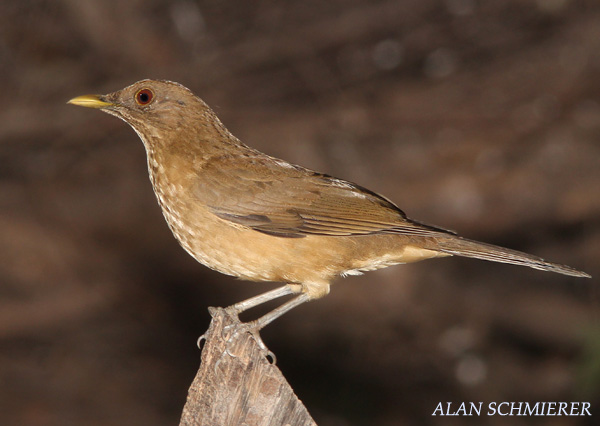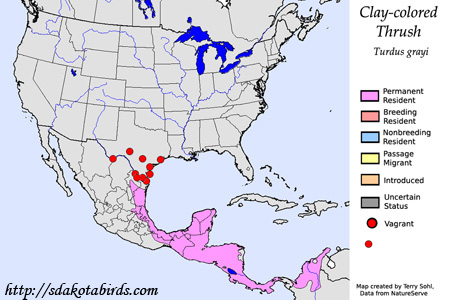| Length: 9 inches | Wingspan: 14.75 inches | Seasonality: Non-resident in South Dakota |
| ID Keys: Warm brownish overall, paler underneath, light throat with darker streaks, yellowish bill with darker base | ||
 The
Clay-colored Thrush is a thrush species primarily found in Mexico. In
the United States they are known from many sightings in southern Texas.
The species appears to be expanding their range to the north, and sightings
have become increasingly common in Texas. Most United States sightings are
of birds in the winter, but Clay-colored Thrush are increasingly found as
breeding birds in southern Texas. They were formerly called
"Clay-colored Robin".
The
Clay-colored Thrush is a thrush species primarily found in Mexico. In
the United States they are known from many sightings in southern Texas.
The species appears to be expanding their range to the north, and sightings
have become increasingly common in Texas. Most United States sightings are
of birds in the winter, but Clay-colored Thrush are increasingly found as
breeding birds in southern Texas. They were formerly called
"Clay-colored Robin".
Habitat: .Found in a variety of open and semi-open habitats, including forest clearings and edges, second-growth forest, open woodlands, riparian areas, and scattered groves of trees. They have adapted extremely well to a human presence, and are a very common sight in suburban areas and parks.
Diet: Feeds on worms, insects, and other small invertebrates, but will also take fruits and berries.
Behavior: Foraging often occurs on the ground, particularly when they are feeding on insects and other invertebrates. However, they may also feed in the forest canopy, particularly when feeding on fruits.
Nesting: The nest is a cup built of grasses, moss, leaves, rootlets, and other fine material, typically found together with mud. The nest is placed in a shrub or tree, but in urban areas may also be placed on a man-made structure. The female lays between 2 and 4 eggs, and she alone incubates them. The eggs hatch after about 2 weeks, with both parents helping to raise the young. The young fledge about 2 weeks after hatching.
Song: The song is a series of sweet, warbling phrases, often compared to a similar song of an American Robin.
Migration: Considered a permanent resident throughout their normal range.
Feeders: They will occasionally attend feeders for offered fruits.
Interactive eBird map: Click here to access an interactive eBird map of Clay-colored Thrush sightings
Similar Species: For vagrants found in southern Texas, they are most likely to be confused with American Robin, primarily because of overall structure; plumage differences are obvious. They could also be confused with Rufous-backed Robin, another vagrant from Mexico that is occasionally found in southern Texas.
Conservation Status: Populations are found over a relatively broad geographic area, they are common in many parts of their range, and overall populations appear to be increasing. The IUCN lists the Clay-colored Thrush as a species of "Least Concern".
Further Information: 1) BirdLife International - Clay-colored Thrush
2) WhatBird - Clay-colored Thrush
3) Audubon Guide - Clay-colored Thrush
Photo Information: Photo by Alan Schmierer - November 6th, 2013 - Mission, Texas - Public Domain photo
| Click below for a higher-resolution map |
 |
| South Dakota Status: Non-resident in South Dakota |
Additional Clay-colored Thrush Photos (coming soon!!)
